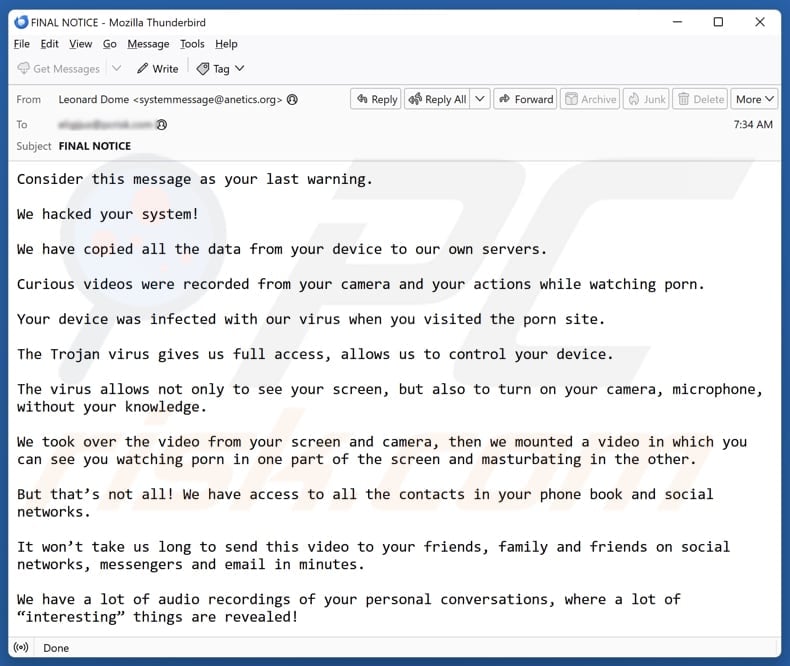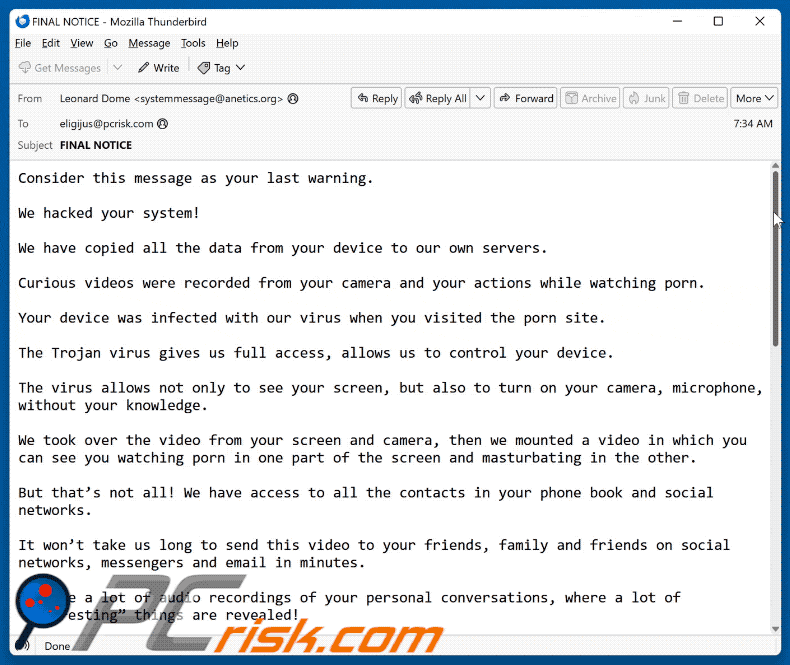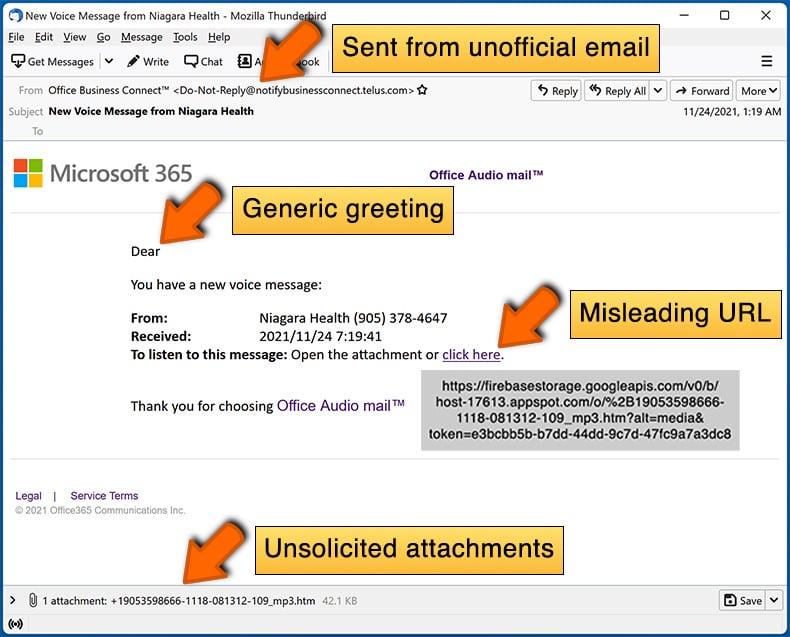How to identify scams like "Consider This Message As Your Last Warning"
Phishing/ScamAlso Known As: Consider This Message As Your Last Warning sextortion scam
Get free scan and check if your device is infected.
Remove it nowTo use full-featured product, you have to purchase a license for Combo Cleaner. Seven days free trial available. Combo Cleaner is owned and operated by RCS LT, the parent company of PCRisk.com.
What kind of scam is "Consider This Message As Your Last Warning"?
Our team has reviewed the email and concluded that it is a sextortion scam. Its purpose is to trick recipients into believing that their computers have been compromised and paying a ransom. All claims made in this scam email are untrue. Recipients should ignore this message.

More about the "Consider This Message As Your Last Warning" scam email
The email claims that the sender hacked the recipient's system and copied all data to their servers. It claims videos were recorded of the recipient watching pornography and that the attackers can access the screen, camera, and microphone.
It states the device was infected through an adult site and that the attackers created a compromising video while collecting audio recordings and the recipient's contacts. The sender threatens to distribute this material to friends, family, social networks, messengers, and email unless a ransom of $5000 is paid in Bitcoin.
The email says that the recipient has 50 hours to act and threatens that reporting or sharing it will lead to immediate release of the material. It also claims that Bitcoin payments and the attacker's email are untraceable.
Overall, this is a sextortion scam, which falsely claims the sender has compromising videos or data to extort money. Recipients do not need to be concerned about the claims, as they are fake. They should ignore the email and not send any payment.
| Name | Consider This Message As Your Last Warning Email Scam |
| Threat Type | Phishing, Scam, Social Engineering, Fraud |
| Fake Claim | The sender hacked the device, recorded compromising videos, and will release them unless a ransom is paid |
| Scammer's BTC Wallet Address | bc1qfgtfgxsychphe9hxtnfp83xsg2fa5fteesf270 |
| Ransom Amount | $5000 |
| Symptoms | Unauthorized online purchases, changed online account passwords, identity theft, illegal access of the computer. |
| Distribution methods | Deceptive emails, rogue online pop-up ads, search engine poisoning techniques, misspelled domains. |
| Damage | Loss of sensitive private information, monetary loss, identity theft. |
| Malware Removal (Windows) |
To eliminate possible malware infections, scan your computer with legitimate antivirus software. Our security researchers recommend using Combo Cleaner. Download Combo CleanerTo use full-featured product, you have to purchase a license for Combo Cleaner. 7 days free trial available. Combo Cleaner is owned and operated by RCS LT, the parent company of PCRisk.com. |
Similar scam emails in general
Scams like this try to scare people into paying money by claiming their personal data or videos were stolen. The threats are fake, and the attackers do not actually have access to computers. The best approach is to ignore such emails, never pay, and report them as scams.
Examples of similar scams are "You Visited Some Hacked Websites With Exploit", "Data From All Your Devices Is Copied To My Servers", and "We Hacked Your System". It is important to note that scam emails can be used to distribute malware.
How do spam campaigns infect computers?
Threat actors can distribute malware via email attachments, such as malicious MS Office documents, PDFs, scripts, executables, archive files like ZIP or RAR, etc. Opening these files or taking additional steps can activate the malware and infect the system.
Malware can also be delivered through emails containing links to fake or compromised websites. These websites either automatically download malicious software or trick users into manually downloading and running it.
How to avoid installation of malware?
Always be careful with emails or messages from unknown senders, especially if they seem suspicious or irrelevant. Avoid opening attachments or clicking links in these messages. When visiting dubious websites, ignore ads and pop-ups, and block notifications from sites of this kind (if they request permission to show them).
Protect your devices with reliable antivirus software, run regular scans, and keep your operating system and apps up to date. Download software from official or reputable sources.
The appearance of "Consider This Message As Your Last Warning" scam email (GIF):

Text presented in the "Consider This Message As Your Last Warning" email letter:
Subject:FINAL NOTICE
Consider this message as your last warning.
We hacked your system!
We have copied all the data from your device to our own servers.
Curious videos were recorded from your camera and your actions while watching porn.
Your device was infected with our virus when you visited the porn site.
The Trojan virus gives us full access, allows us to control your device.
The virus allows not only to see your screen, but also to turn on your camera, microphone, without your knowledge.
We took over the video from your screen and camera, then we mounted a video in which you can see you watching porn in one part of the screen and masturbating in the other.
But that's not all! We have access to all the contacts in your phone book and social networks.
It won't take us long to send this video to your friends, family and friends on social networks, messengers and email in minutes.
We have a lot of audio recordings of your personal conversations, where a lot of "interesting" things are revealed!
This information can destroy your reputation once and for all in a matter of minutes.
You have an opportunity to prevent irreversible consequences.
To do this:
Transfer 5000$ USD (US dollars) to our bitcoin wallet.
Don't know how to make a transfer? Enter the query "Buy bitcoins" into the google search field.
Our bitcoin wallet is below
bc1qfgtfgxsychphe9hxtnfp83xsg2fa5fteesf270
After making the payment, your video and audio recordings will be completely destroyed and you can be 100% sure that we won't bother you again.
You have time to think about it and make the transfer - 50 hours!
After you read this letter, we will get an automatic notification. From that moment on, the timer will start.It is useless to complain, because bitcoin-wallets cannot be tracked, as well as the mail from which the letter arrived to you.
We also do not advise you to send this letter to anybody.In this case the system will automatically send a request to the server, and all data will be published in social networks and sent to all your contacts we extracted from your email and we also have a special package for your spous .
You will not be able to solve the problem by changing passwords in social networks, as all the information is already downloaded to the cluster of our servers.
Think about what your reputation means to you and how much the consequences will be if you think its a bluff wait for time to expire .
You have 50 hours.
Instant automatic malware removal:
Manual threat removal might be a lengthy and complicated process that requires advanced IT skills. Combo Cleaner is a professional automatic malware removal tool that is recommended to get rid of malware. Download it by clicking the button below:
DOWNLOAD Combo CleanerBy downloading any software listed on this website you agree to our Privacy Policy and Terms of Use. To use full-featured product, you have to purchase a license for Combo Cleaner. 7 days free trial available. Combo Cleaner is owned and operated by RCS LT, the parent company of PCRisk.com.
Quick menu:
- What is Consider This Message As Your Last Warning sextortion scam?
- Types of malicious emails.
- How to spot a malicious email?
- What to do if you fell for an email scam?
Types of malicious emails:
![]() Phishing Emails
Phishing Emails
Most commonly, cybercriminals use deceptive emails to trick Internet users into giving away their sensitive private information, for example, login information for various online services, email accounts, or online banking information.
Such attacks are called phishing. In a phishing attack, cybercriminals usually send an email message with some popular service logo (for example, Microsoft, DHL, Amazon, Netflix), create urgency (wrong shipping address, expired password, etc.), and place a link which they hope their potential victims will click on.
After clicking the link presented in such email message, victims are redirected to a fake website that looks identical or extremely similar to the original one. Victims are then asked to enter their password, credit card details, or some other information that gets stolen by cybercriminals.
![]() Emails with Malicious Attachments
Emails with Malicious Attachments
Another popular attack vector is email spam with malicious attachments that infect users' computers with malware. Malicious attachments usually carry trojans that are capable of stealing passwords, banking information, and other sensitive information.
In such attacks, cybercriminals' main goal is to trick their potential victims into opening an infected email attachment. To achieve this goal, email messages usually talk about recently received invoices, faxes, or voice messages.
If a potential victim falls for the lure and opens the attachment, their computers get infected, and cybercriminals can collect a lot of sensitive information.
While it's a more complicated method to steal personal information (spam filters and antivirus programs usually detect such attempts), if successful, cybercriminals can get a much wider array of data and can collect information for a long period of time.
![]() Sextortion Emails
Sextortion Emails
This is a type of phishing. In this case, users receive an email claiming that a cybercriminal could access the webcam of the potential victim and has a video recording of one's masturbation.
To get rid of the video, victims are asked to pay a ransom (usually using Bitcoin or another cryptocurrency). Nevertheless, all of these claims are false - users who receive such emails should ignore and delete them.
How to spot a malicious email?
While cyber criminals try to make their lure emails look trustworthy, here are some things that you should look for when trying to spot a phishing email:
- Check the sender's ("from") email address: Hover your mouse over the "from" address and check if it's legitimate. For example, if you received an email from Microsoft, be sure to check if the email address is @microsoft.com and not something suspicious like @m1crosoft.com, @microsfot.com, @account-security-noreply.com, etc.
- Check for generic greetings: If the greeting in the email is "Dear user", "Dear @youremail.com", "Dear valued customer", this should raise suspiciousness. Most commonly, companies call you by your name. Lack of this information could signal a phishing attempt.
- Check the links in the email: Hover your mouse over the link presented in the email, if the link that appears seems suspicious, don't click it. For example, if you received an email from Microsoft and the link in the email shows that it will go to firebasestorage.googleapis.com/v0... you shouldn't trust it. It's best not to click any links in the emails but to visit the company website that sent you the email in the first place.
- Don't blindly trust email attachments: Most commonly, legitimate companies will ask you to log in to their website and to view any documents there; if you received an email with an attachment, it's a good idea to scan it with an antivirus application. Infected email attachments are a common attack vector used by cybercriminals.
To minimise the risk of opening phishing and malicious emails we recommend using Combo Cleaner Antivirus for Windows.
Example of a spam email:

What to do if you fell for an email scam?
- If you clicked on a link in a phishing email and entered your password - be sure to change your password as soon as possible. Usually, cybercriminals collect stolen credentials and then sell them to other groups that use them for malicious purposes. If you change your password in a timely manner, there's a chance that criminals won't have enough time to do any damage.
- If you entered your credit card information - contact your bank as soon as possible and explain the situation. There's a good chance that you will need to cancel your compromised credit card and get a new one.
- If you see any signs of identity theft - you should immediately contact the Federal Trade Commission. This institution will collect information about your situation and create a personal recovery plan.
- If you opened a malicious attachment - your computer is probably infected, you should scan it with a reputable antivirus application. For this purpose, we recommend using Combo Cleaner Antivirus for Windows.
- Help other Internet users - report phishing emails to Anti-Phishing Working Group, FBI’s Internet Crime Complaint Center, National Fraud Information Center and U.S. Department of Justice.
Frequently Asked Questions (FAQ)
Why did I receive this email?
Scammers often get email addresses from data leaks or unsafe websites. They usually send the same message to many people at once, so these emails are not directed at specific individuals.
I have provided my personal information when tricked by this email, what should I do?
Immediately reset all your passwords if you provided login credentials. If you also shared personal information (such as credit card or ID details), notify the authorities.
I have downloaded and opened a malicious file attached to an email, is my computer infected?
A common way computers get infected is through harmful files, for example by running malicious executables or enabling macros in compromised Office documents. The possibility of the infection varies depending on the file involved.
Was my computer actually hacked and does the sender have any information?
Your computer was not hacked or infected. Typically, scammers behind such emails only claim that they have stolen details or accessed computers.
I have sent cryptocurrency to the address presented in such email, can I get my money back?
Such payments are essentially untraceable and irreversible, which means recovery is usually not possible.
I have read the email but did not open the attachment, is my computer infected?
There is no risk in viewing an email. Threats appear when unsafe links are clicked or attachments are opened.
Will Combo Cleaner remove malware infections that were present in email attachment?
Combo Cleaner can detect and clean most malware infections. To ensure hidden threats are found, a full system scan must be run.
Share:

Tomas Meskauskas
Expert security researcher, professional malware analyst
I am passionate about computer security and technology. I have an experience of over 10 years working in various companies related to computer technical issue solving and Internet security. I have been working as an author and editor for pcrisk.com since 2010. Follow me on Twitter and LinkedIn to stay informed about the latest online security threats.
PCrisk security portal is brought by a company RCS LT.
Joined forces of security researchers help educate computer users about the latest online security threats. More information about the company RCS LT.
Our malware removal guides are free. However, if you want to support us you can send us a donation.
DonatePCrisk security portal is brought by a company RCS LT.
Joined forces of security researchers help educate computer users about the latest online security threats. More information about the company RCS LT.
Our malware removal guides are free. However, if you want to support us you can send us a donation.
Donate
▼ Show Discussion